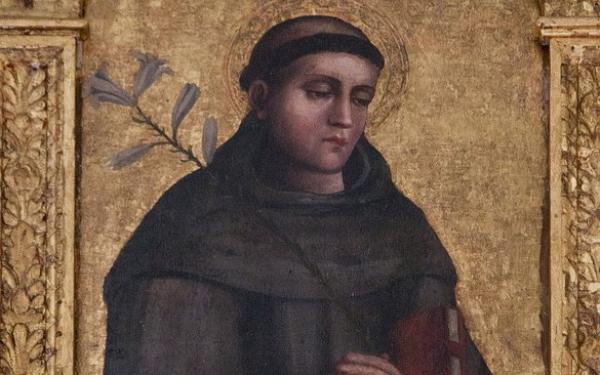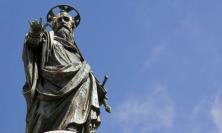The conclave that will elect the successor to Pope Benedict XVI begins tomorrow, Tuesday 12 March. With the Church on the brink of a new chapter in its history, John Moffatt SJ finds a new way to think about the choices ahead in the ideas of St Bonaventure, whose theology was a great influence on Pope Benedict. Are we moving from an ‘age of clear teaching’ into a new ‘age of Ezra’?
In the last month I have been trying to get a better grasp on the texts that might have inspired the thought of Joseph Ratzinger, now our first Pontifex Emeritus. I was, alas, unable to track down a copy of his habilitation thesis, The Historical Theology of St Bonaventure. But I was able to set my eyes on Bonaventure’s Analogies On The Six Days. There were several things in the text that caught my attention, but one that stayed with me was in his sixteenth presentation of riffs on the opening chapter of Genesis. Here each of the days of creation prefigures one of the seven ages of the Old Covenant and each of these ages in turn prefigures one of the seven ages of the New Covenant. The Old Covenant ages include (unsurprisingly) ‘the age of kingly glory’ and (the sixth age) ‘the age of the prophetic voice’. But the title of the New Covenant age corresponding to the latter was striking. This Bonaventure calls the age of clara doctrina – clear teaching. It begins with Charlemagne and continues to his own century. He roots its character in the fact that Charlemagne got the clergy together, produced definitive books on liturgy and doctrine and established a religious order throughout the Empire in Western Europe.
Maybe this passage has accompanied Joseph Ratzinger throughout his life or maybe not. But if there is one thing that has characterized the Roman Catholic Church in the three decades since he took a share in responsibility for the teaching of the faith, it is the clear statement of that teaching. As prefect of the Congregation for the Doctrine of Faith he oversaw the production of the Catechism of the Catholic Church – a single universal basis for Catholic instruction – and chastened theologians around the world. He has promoted the attempt to establish a greater liturgical uniformity in the celebration of the ordinary Roman Rite. The new English translation of the Mass was produced under the aegis of Vox Clara (sounds better in Latin) during his papacy. His final encyclical, Caritas in Veritate affirms the tradition of papal social teaching from Leo XIII through Paul VI to John Paul II in the light of global ethical challenges and unifies it with the teaching on sexuality, family life and life-issues that have dominated internal Catholic controversies in the twentieth and twenty-first centuries.
Indeed, he leaves the Church fortified with clara doctrina. But what comes next? In Bonaventure’s scheme it is the seventh ‘age of final rest’, prefigured by the ‘age of half-way rest’, when the temple was rebuilt, the cult restored and peace was granted. This is the period from Ezra until the birth of Christ. However, that same period is actually a rather more complex and interesting one than Bonaventure’s title suggests. Its ambivalence has echoes in our own age.
Let us begin with the Ezra story, which exists in a number of variants. Towards the end of the fifth century BCE, either Ezra or Nehemiah (or both) leads a second wave of Jewish exiles out of Persia. When they reach Jerusalem they find things chaotic. The walls are broken down, the Temple only half built. The order of events is different in the Books of Ezra and Nehemiah, but the key scene is the same. Ezra the priest-scribe stands up in front of the people and reads them the Law, translating as he goes. Others are appointed to the task of explaining it to the people. Then, at the end they have to go round telling the people not to weep. They should be rejoicing, it is a festival.
Why might they be crying? Well, they may be mourning like Josiah in 2Kings that they have been getting so much wrong for so long. Perhaps these are tears of repentance. But there is one more immediate issue that is reported in various different ways. They are going to be obliged to separate themselves from the people of the land, and some of them are going to have to divorce their non-Jewish wives and husbands. Strict obedience to the Law and membership of the newly reconstructed Jerusalem will, for some people more than others, involve a real human cost. Not all are willing to pay that cost, and Nehemiah, the governor, is apparently obliged to give some a beating and to pull out the hair of others. Some just leave. This moment of clara doctrina leaves a Jerusalem (notionally) filled with perfectly law-abiding citizens.
Thus the Temple and the cult were restored. But what about that age of rest? In fact, within 150 years Jews from Jerusalem to North Africa and Asia Minor become part of the Hellenistic world. Ezra’s Law met the different streams of Hellenistic thought. Intellectual Jews engaged in a dialogue with that thought, which had an effect, direct and indirect, on all subsequent Jewish reflection. Some traces can be found in the translation choices of the Septuagint, the Jewish Bible translated into Greek for the many communities who no longer understood Hebrew or Aramaic. We see traces, too, in some of the later writings of the Old Testament, and in the many examples of Greek-Jewish writing preserved by later Christian writers.
The uniformity of practice that Ezra preaches gives way to interpretation and diversification as people encounter new worlds to think in and to live in. Clara doctrina cannot command its own interpretation, and human life, doctrina’s best reality check, demands dynamic translation. Even after the persecution of Antiochus, which led to reforms and a reaction against Greek culture in Jerusalem, the reformed religion was, in spite of the one clear Torah at its base, pluriform. The Jewish author Josephus looks back on the period from the first century CE. In one text he proudly declares the unity of his people, with their one high priest and one law and a set of distinctive behaviours that all practise. The same Josephus elsewhere describes three different schools of practice of the Torah, with various degrees of accommodation to wider realities or to specific philosophical or religious concerns. He also mentions two alternative temples to the one in Jerusalem, run by rival high priests, quite apart from the sect of John the Baptist.
Wider archaeological and epigraphic evidence from the period points to a range of degrees of belonging for those of Jewish heritage outside Judea and Galilee. Some people acculturated more and some less in the melting pot of the Eastern Mediterranean, under first Greek then Roman rule. Tellingly, the things that became important for determining whether you were genuinely in or out were not central matters of theology, but the distinctive practices of male circumcision and the dietary laws. We see echoes of these specific concerns in the tensions within and between early Christian communities.
Let us return to our own situation. We could play with the thought that after an age of clara doctrina the Catholic Church stands on the threshold of a new age of Ezra. Whatever our vision for the Church over the next two centuries, the narrative offers an interesting way of framing our choices.
First and foremost is how we choose to think of ourselves. Maybe we are perfect members of the Holy City, its walls newly built to keep out our enemies. Alternatively we could see ourselves as part of the confusion of humanity, in every age trying to find new and better ways of living with each other in peace and friendship. And is the crucial test of faith our desire to find God, to hear how Jesus Christ is leading us in the midst of a complex world? Or is it conformity to a few distinctive behaviours highlighted as critical by our beleaguered faith community?
In fact, despite the emergence of the modern clara doctrina Catholicism is currently still fairly pluriform. That is perhaps how it manages to keep a billion members on its books across the globe. Traditionally the Church talks romantically about ‘the faithful’, but lives with the fact that Catholics (clergy and laity) are a pretty unruly bunch, who have their own ideas and make their own choices about which bits of doctrina they can cope with, in order to carry on belonging as best they can. At its worst this can mean pretending abusive and unethical behaviour is not happening. At its best it allows people who are trying to live or think with integrity on the wrong side of one of our modern distinctives (by using artificial contraception for instance) some pastoral latitude. This human reality is in obvious tension with having clear teaching.
So here is another more critical choice. Do we want to follow that clear teaching’s normative logic? Do we want to move from our actual diversity to a reformed Ezra-Catholicism in which all of us behave ourselves according to the book? If that is indeed what we want then we must be prepared for tears and separations. And possibly some hair-pulling.
Then, of course, there is the question of how we talk to people on the other side of the wall. The lesson of history is that whatever worthwhile doctrina we have has emerged thanks to intelligent conversations that include people on the other side. However, our current preferred narrative is that we already have a clearly stated truth, and it would be better if everyone else just did what we said.
Thus, in a confusing world, official Catholicism has chosen the modern distinctives that set us apart from the rest. The teaching of Humanae Vitae and its extension to the question of civic recognition of same sex unions, alongside a range of bio-ethical issues, together have become our equivalent of circumcision and food laws. Church leaders have been appointed and church thinkers listened to according to whether they were prepared to affirm just those distinctives. As a result, the Church’s claim to be a universal voice speaking to all humanity has become much weaker over the last two decades. Because argument and evidence is selected on the basis of the preferred answer rather than the complexity of reality, official philosophy underpinning the official claims is fast becoming a Catholic version of creation science.
One example of note is John Paul II’s ‘Theology of the Body’. The texts, if read as an invitation to a potentially life-giving form of celibacy or religious married life, are rich and moving. They have helped many people. Read as a universal, normative account of human sexuality, they are more problematic and do not ring true with outsiders literate in philosophy and psychology. Other Catholic theologians and philosophers, meanwhile, are having more interesting, and potentially more fruitful conversations outside the wall, which the rest of us never get to hear about.
Nevertheless, we seem to be committed to the Ezra Church, defined by just these distinctives. How are we then to proceed? Consistency might require us to order the separation, cut off from our midst those who do not keep these laws. The more robust way of doing so would be to exclude from the community all who fail the distinctives test in thought, word and deed – laity and clergy alike.
To avoid periodic culls, we could from now on only baptise adults who sign up to the complete set of rules.
A milder approach might be simply to exclude them from communion, as some clergy already do. This way, the Church would, overnight, look much more like the pre-reformation Church, though now with two forms of religious life, one celibate, one married, including clergy and lay in each. Catholics of the strict observance would be able to take communion at Mass, while the rest of us sat sinfully at the back, perhaps confessing and communicating once a year. Of course, many, finding their personal integrity called into question, would prefer simply to leave. Hundreds of thousands in the West already have. But many others, recognising their personal need for the sacred, would continue to hang on in. Meanwhile, the purified Church would go serenely on, like the Church of Augustine, surrounded by a large and anxious cloud of those who are not yet ready to give up their foreign wives and husbands.
Or is there another way of asserting the worth hidden in those distinctives and honouring those who find them nourishing to live by, without condemning the rest of humanity? There is a model for this in religious life. The three vows of poverty, chastity and obedience do not make sense to everyone, but for some, they are the way that gives life and they imply no criticism of others who cannot take them. Could this set us on the way to ending the wearing and unnecessary (some will be necessary) wars with our neighbours outside? Can we, officially, have intelligent conversations with them, learn from them and so teach better than we did before about what it is to be human before God?
If the answer to some of these questions is ‘yes’ then perhaps our clear teaching will cease to be a dividing wall. Perhaps we will learn to see ourselves again as world-citizens, who carry (through no merit of our own) the gift of a life-giving wisdom, a wisdom that we discover by engaging generously and attentively with our world. This might be a wisdom that all men and women of good will could appreciate again, a pathway to God and to true humanity through the maze of human time.
John Moffatt SJ teaches Scripture at the Jesuit Institute, South Africa and is the author of www.moffatt.wordpress.com.
![]() http://www.moffatt.wordpress.com/
http://www.moffatt.wordpress.com/






